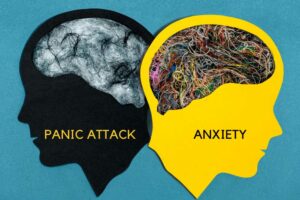As more people experience mental health issues, words like “anxiety” and “panic attack” are used more frequently in conversations. Many people use them interchangeably or in situations where they may not apply. Understanding the differences can help you or other people in your life get the right type of treatment.
What is a Panic Attack?
Like the word “attack” implies, a panic attack is a sudden and overwhelming fear. This intense experience typically causes you to mentally and physically go into fight-or-flight mode in the most extreme ways. While a panic attack sounds like it would primarily be a mental issue, it is the physical symptoms of a panic attack that are most noticeable and alarming. Some symptoms of a panic attack can include:
- Paralyzing fear, or fear of death
- Feeling detached from yourself or your body
- Fear of losing control
- Heart pounding, palpitations, or increased heart rate
- Chest pains
- Shortness of breath
- Throat tightening or a choking sensation
- Profuse sweating
- Hot flashes or chills
- Dry mouth
- Shaking or trembling
- Tingling or numbing sensations
- Upset stomach, nausea, or other abdominal pain
- Dizziness or fainting feelings
- Headache
Panic attacks are often triggered by a phobia, past trauma, or a sudden increase in stress. Many panic attacks last around 10-15 minutes, but some can last longer or occur one after the other, making it difficult to tell how long they last.
What is Anxiety?
Anxiety has many of the same physical symptoms as a panic attack but is based on fears or worries that typically build up slowly and are long-lasting. Fears or worries about something real (or perceived as dangerous or harmful) can be at the back of your mind for a long time or keep you up at night in anticipation. One type of anxiety is social anxiety, which is characterized by a fear of being judged by others in public situations. While many of the physical symptoms can include those listed above, some of the additional symptoms of anxiety include:
- Restlessness and trouble sleeping
- Irritability or lashing out in anger
- Difficulties concentrating
- Fatigue
- Muscle tension and pain in limbs
- Startling easily
While there are many shared symptoms between anxiety and panic attacks, anxiety typically produces less intense symptoms. Unfortunately, however, the symptoms have greater longevity and can be more detrimental to your overall health and ability to function.
What are the Differences Between Anxiety and Panic Attacks?
The main difference between anxiety and a panic attack is that with anxiety, the symptoms may be less intense, but they build up over time and are long-lasting. Anxiety is more likely to be caused by seemingly innocuous things, while a panic attack is more often triggered by a known issue such as a phobia or past traumatic events. Anxiety is a long-term condition that is less likely to be noticed and could be characterized by “nagging thoughts and fears.” A panic attack is usually immediately noticeable and can cause you to freeze or become non-responsive.
How Do You Treat a Panic Attack?
Panic attacks should be reported to your doctor, including what was happening right before the attack, or any known triggers. It is important to note your symptoms and how often they occur if they have happened more than once. Your doctor may prescribe medications to use as needed; however, the best treatment for panic attacks is therapy, particularly to address known triggers or trauma. Learning skills like mindfulness, breathing, and relaxation exercises can also be helpful.
How Do You Treat Anxiety?
Similarly, you should talk to your doctor about anxiety symptoms. Many symptoms are discovered within health problems that occur as a result of long-term anxiety, such as stomach problems, blood pressure, or heart problems. If it is determined that the problems are caused by anxiety, therapy such as Cognitive Behavioral Therapy (CBT) may be able to treat the underlying anxiety, potentially helping to heal the health symptoms, as well. There are anti-anxiety medications, but it is important to talk to your doctor about the risks and benefits of these medications. Self-help skills like breathing and relaxation techniques, as well as mindfulness meditation, are also great to implement daily and can help when you notice anxiety building up.
Whether you suffer from anxiety or panic attacks, it is important to get the help you need to prevent short or long-term interference in your ability to function. If you are in treatment or recovery for substance abuse, both panic attacks and anxiety are common. However, by treating the cause of your addiction, you may also be able to treat the source of your anxiety or panic attacks.
What is the difference between a panic attack and anxiety? Both can cause physical symptoms that are frightening and difficult to understand. While a panic attack can come on suddenly, anxiety is usually long-lasting and slower to build up. Both can be debilitating and interfere with your mental and physical health, so it is important to seek medical and therapeutic treatment if you experience either of these conditions. At Promising Outlook, we understand the relationship between being in recovery for drug or alcohol addiction and struggling with anxiety or panic attacks. Our outpatient facility provides individual and group therapy, and we specialize in addressing past trauma that can cause these conditions. Call our Riverside, California center at 866.980.2869 to find out how we can help you heal from substance abuse and any co-occurring anxiety or panic attacks. Let us help you free yourself from addiction and heal. You don’t need to live in fear. Call us today.






